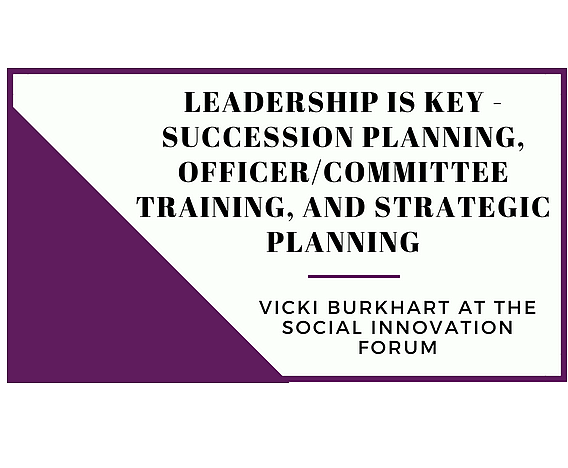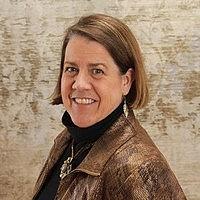
On June 11, the Social Innovation Forum hosted the third workshop in our board development series with Vicki Burkhart, the nonprofit growth strategist leading The Burkhart Group. The first two sessions focused on How to Build the Right Board for Organizational Growth and Building Board Culture & Strategies for Dealing with Challenging Board Members. The third workshop in the series was Leadership is Key - Succession Planning, Officer/Committee Training, and Strategic Planning. The workshop included nonprofit leaders and board members from SIF's alumni portfolio, coworking members, and Social Innovator Accelerator finalists. Here are some key takeaways.
Leadership Succession Planning

Vicki Burkhart, the non-profit growth strategist leading the Burkhart Group.
Succession planning within your board is essential to producing strong, prepared leadership and consistency with strategic goals. Rather than an impromptu decision based on either popularity or the “lesser of two evils,” electing new leadership should be a thoughtful process that begins with recruitment. Vicki suggests that when considering new board members, you should ask them if they could ever see themselves as Board President -- this provides great insight into their commitment and leadership potential. Your succession plan should be navigated by your board development committee, who knows your members and their strengths well, and who sets a defined path to leadership in terms of training and timelines. The succession plan should be well documented and should reach beyond the Board President to committee chairs and other leadership, including the Executive Director.
Vicki suggested a sample 5-year Succession Progression for Presidency that she has found very effective in her work:
- One year term as President Elect, to learn the ropes from the current president. The position should feature concrete responsibilities, often including chairing the Strategic Plan Committee.
- Two year term as President.
- Two year term as Immediate Past President, to serve as a mentor and advisor to current President. They often serve as chair of the Board Development Committee.
Officer Training & Preparation
A key component to board leadership is to establish the leader’s vision. The board’s goals should always reflect the organization’s strategic plan, but the Board President’s vision will set the priorities during their term, based on individual passion for the organization. New officers should actively create a working relationship with the Executive Director/CEO. Vicki suggests scheduling weekly one-on-one meetings to touch base, talk through issues, and make sure the officer truly understands the staff’s work. When building a leadership team on your board, establishing overlap between officer terms can help ensure continuity and more effective training. Lastly, organizing leadership training and board retreats during times of transition are excellent ways to build connections within your board and establish new leadership.
Board Committees
Establishing effective board committees requires clear written descriptions, carefully selected members, and strong leadership. Committees should always be seen as a subset of the board that reports back to the Board President and other board members. Committees are created to further the goals of the strategic plan. In Vicki’s experience, each board should have (around) four committees, including a Finance Committee, a Board Development Committee, and other program committees depending on the organization. She suggests using Ad Hoc Committees or task forces for specific, short term projects rather than creating a standing committee. Short term projects with a carefully selected group of members will have more energy, engagement, and impact than committees that meet indefinitely. Each board member should sit on a maximum of two committees to ensure they are as engaged and active as possible on each. When necessary, include a staff member on each committee for briefing on certain projects. However, be mindful of the staff’s best use of time and remember that they do not have board member responsibilities.
Planning: Short term, long term, and strategic
To clear up some common confusion, Vicki clearly explained the differences between short term, long term, and strategic planning.
- Short term planning has an operational focus, has goals based on a timeline of 1-12 months, and aims for results that provide evidence of the organization’s success towards their mission.
- Long term planning is often project-based, has goals based on a timeline of several years, and relies on current knowledge about future conditions for implementation.
- Strategic planning is usually in the form of a three-year strategic plan. This creates a vision of your ideal organization through a systematic process that outlines where your organization wants to go and how to get there. Your strategic plan serves as the roadmap to drive your organization, staff, and board.
To learn more about board development or to set up a training at your organization, contact Vicki Burkhart of The Burkhart Group at vsb@burkhartgroup.com.
 Social Innovation Forum
Social Innovation Forum